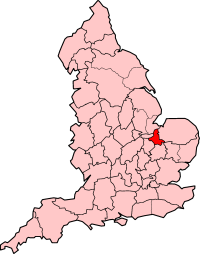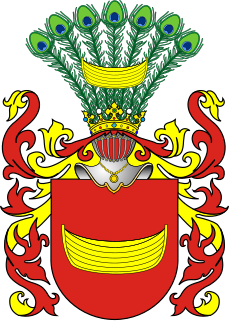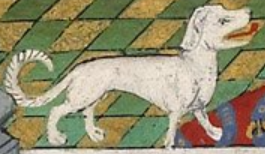
A coat of arms is a heraldic visual design on an escutcheon, surcoat, or tabard. The coat of arms on an escutcheon forms the central element of the full heraldic achievement, which in its whole consists of a shield, supporters, a crest, and a motto. A coat of arms is traditionally unique to an individual person, family, state, organization, school or corporation. The term itself of 'coat of arms' describing in modern times just the heraldic design, originates from the description of the entire medieval chainmail 'surcoat' garment used in combat or preparation for the latter.

Hereward the Wake (c.1035 – c.1072) was an Anglo-Saxon nobleman and a leader of local resistance to the Norman Conquest of England. His base, when leading the rebellion against the Norman rulers, was the Isle of Ely in eastern England. According to legend he roamed the Fens, which nowadays covers the parts of the modern counties of Cambridgeshire, Lincolnshire and Norfolk, leading popular opposition to William the Conqueror.

The Isle of Ely is a historic region around the city of Ely in Cambridgeshire, England. Between 1889 and 1965, it formed an administrative county.

The Carrick bend, also known as the Sailor's breastplate, is a knot used for joining two lines. It is particularly appropriate for very heavy rope or cable that is too large and stiff to be easily formed into other common bends. It will not jam even after carrying a significant load or being soaked with water.

Bourne is a market town and civil parish in the South Kesteven district of Lincolnshire, England. It lies on the eastern slopes of the limestone Kesteven Uplands and the western edge of the Fens, 11 miles north-east of Stamford, 12 miles west of Spalding and 17 miles north of Peterborough. The population at the 2011 census was 14,456. A 2019 estimate put it at 16,780.

The House of Howard is an English noble house founded by John Howard, who was created Duke of Norfolk by King Richard III of England in 1483. However, John was also the eldest grandson of the 1st Duke of the first creation. The Howards have been part of the peerage since the 15th century and remain both the Premier Dukes and Earls of the Realm in the Peerage of England, acting as Earl Marshal of England. After the English Reformation, many Howards remained steadfast in their Catholic faith as the most high-profile recusant family; two members, Philip Howard, 13th Earl of Arundel, and William Howard, 1st Viscount Stafford, are regarded as martyrs: a saint and a blessed respectively.

The coat of arms of Birmingham – the heraldic emblem of the English city of Birmingham – was first used in 1838 and has changed several times since, as the former town grew and developed into a city.

Łodzia is a Polish coat of arms. It was used by many noble families of the Kingdom of Poland and the Polish–Lithuanian Commonwealth. A variant serves as the coat of arms of the city of Łódź. It's a classic example of the so-called canting arms well known in European heraldry as it was borne by the medieval lords de Łodzia and their clan. Hence the boat in the shield, clearly alluding to the estate's name literally meaning Boat. Coats of Arms in the Polish Lithuanian Commonwealth were a symbol of a heraldic clan.

The Talbot was a type of hunting hound common in England during the Middle Ages. It is depicted in art of the period as small to medium-sized, white in colour, with short legs, large powerful feet, a deep chest with a slender waist, long drooping ears, and a very long curled tail. It is shown in one well-known example at Haddon Hall with a fierce facial expression. It is now extinct, but is believed to be an ancestor of the modern Beagle and Bloodhound. It is uncertain whether it was a scenthound, a sighthound, or a dog used for digging out quarry, nor is it known what type of quarry it hunted, whether deer, fox, boar, etc.
The Stafford knot, more commonly known as the Staffordshire knot, is a distinctive three-looped knot that is the traditional symbol of the English county of Staffordshire and of its county town, Stafford. It is a particular representation of the simple overhand knot, the most basic knot of all.
John Butler, known as John Butler of Kilcash, a member of the Irish landed gentry, was de jure15th Earl of Ormonde and 8th Earl of Ossory. He did not assume these titles as he thought them forfeit by the attainder of the 2nd Duke of Ormond. He did, however, inherit the Ormond estate from the 1st Earl of Arran through Arran's sister Amelia. In 1791, the title of Earl of Ormond would be successfully claimed by his cousin, the 17th Earl.
James Butler, 4th Earl of Ormond was the son of James Butler, 3rd Earl of Ormond. He was called 'The White Earl', and was esteemed for his learning. He was the patron of the Irish literary work, 'The Book of the White Earl'. His career was marked by his long and bitter feud with the Talbot family.
Ivo Taillebois was a powerful Norman nobleman, sheriff and tenant-in-chief in 11th-century England.
Bourne Academy is an 11 to 18 mixed comprehensive school and a co-educational academy located in Bourne, Lincolnshire, England. It is one of two secondary schools, both co-educational, in the town, the other being Bourne Grammar School. Bourne Academy is a part of the South Lincolnshire Academies Trust (SLAT), together with Spalding Academy, Spalding and Giles Academy, Boston.
A heraldic shield has been associated with the historic county of Sussex since the seventeenth century. The device, displaying six martlets or heraldic swallows on a shield, later formed the basis of the flag of Sussex and the armorial bearings granted to the county councils of East and West Sussex.

The Wake Baronetcy, of Clevedon in the County of Somerset, is a title in the Baronetage of England. It was created on 5 December 1621 for Baldwin Wake. The sixth Baronet assumed the additional surname of Jones but died childless. The eighth Baronet sat as Member of Parliament for Bedford. The twelfth Baronet was High Sheriff of Northamptonshire in 1879. The thirteenth Baronet was a Major-General in the British Army. Another member of the family to gain distinction was Charles Wake, second son of the tenth Baronet; he was an Admiral in the Royal Navy.

The coat of arms of Newport is the heraldic emblem of the city of Newport, South Wales. Also known as the Civic Badge, it has been borne by the present Newport City Council since 24 July 1996 following the municipal reorganisation in April that year.

The coat of arms of the London Borough of Camden were granted on 10 September 1965. The borough was formed by the merger of three former boroughs, namely the Metropolitan Borough of Hampstead, the Metropolitan Borough of Holborn and the Metropolitan Borough of St. Pancras, from whose arms elements were utilised in the arms of the new borough.

The coat of arms of the London Borough of Croydon is the official heraldic arms of the London Borough of Croydon, granted on 10 December 1965.

The coat of arms of the London Borough of Hillingdon is the official symbol of the London Borough of Hillingdon. They use elements from the coats of arms of the four previous districts. It is described as:
Arms: Per pale Gules and Vert an Eagle displayed per pale Or and Argent in the dexter claw a Fleur-de-lis Or and in the sinister claw a Cog-Wheel Argent on a Chief Or four Civic Crowns Vert.
Crest: On a Wreath of the Colours issuant from a Circlet of Brushwood Sable a demi-Lion Gules with wings Argent the underside of each wing charged with a Cross Gules and holding between the paws a Bezant thereon a Mullet Azure.
Supporters: On the dexter side an Heraldic Tiger Or gorged with an Astral Crown Azure and charged on the shoulder with a Rose Gules charged with another Argent barbed and seeded proper and on the sinister side a Stag proper attired and gorged with a Circlet of Brushwood and charged on the shoulder with two Ears of Rye slipped in saltire Or.
Motto: Forward.

















